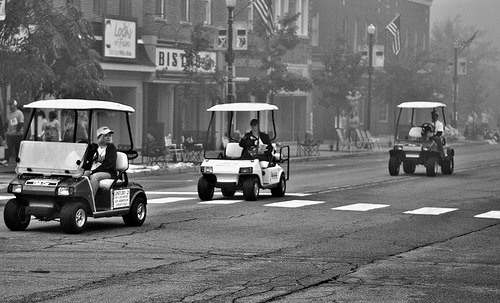Golf carts now legal to drive on some city streets
Golf carts aren’t merely the stuff of prepubescent boys’ driving dreams and elderly golfers’ daily lives – they’re street legal in some areas. Supporters claim that golf carts are friendlier to the environment than their gas-guzzling counterparts, cheaper to run and maintain, and that the vehicles are particularly useful for short trips – which are, statistically speaking, the sorts of rides Americans take most frequently.
According to the Insurance Institute of Highway Safety (IIHS), all but four states have laws permitting golf cart or low-speed vehicle use. (Note: Golf carts aren’t necessarily LSVs. LSV’s reach a maximum speed of around 25 mph, while traditional golf carts clock in under 20 mph. However, certain carts that the IIHS calls “souped up” golf carts, which are faster, do count as LSVs.)

The wave of the future? From Steve Johnson.
Though states’ laws vary, in 2011, the National Highway Traffic Safety Association (NHTSA), set a federal standard to improve across-the-board safety for LSVs used on public streets. The federal safety standards apply to seat belts, headlights, brake lights, turn signals, rearview mirrors and power-to-weight ratios. Still, golf cart use has been left to individual regions to regulate.
And plenty of regions are doing just that: Lyons, Colorado, made golf carts city street-legal in 2008. Bowling Green, Kentucky; Hunters Creek, Texas; and Erie, Colorado, have all approved golf carts for street use. And in Cleveland, Oklahoma, golf carts, ATVs, and UTVs (utility vehicles) are all legal on streets as of this month, pending operators passing a nine-point checklist and obtaining a permit.
Sunny spots like South Carolina are hotbeds for golf cart use – on and off the state’s many renowned golf courses. In St. Pete Beach, Florida, another resort area, residents recently voted to permit golf carts on city streets. And Peachtree, Georgia, is a planned community that offers miles of golf cart-friendly streets. Safety restrictions vary, but, generally, cart operators are required to show proof of insurance, a license, and that their vehicle is outfitted with adequate safety features, like seat belts. Drivers may be restricted from certain streets.

Golf cart parking in Peachtree, GA. From BernardBoyGenius.
Take St. Pete Beach: If the law is passed there, drivers could use the carts on city-owned streets only during daylight hours, without permission for county- or state-regulated streets. (LSVs would have more access). Golf carters would be required to have a driver’s license, pay a $10 license fee, show proof of liability insurance, and demonstrate that the cart is outfitted with reliable brakes, steering, a horn, and tires, plus a rear-view mirror and appropriate reflectors.
In SC, licensed drivers can drive golf carts during daylight hours “on a secondary highway or street within four miles” of her home or business. In Texas, the carts don’t have to be registered with the Department of Transportation; the carts are permitted in master-planned communities, on a beach, on a public highway located within two miles from one’s home or to and from a golf course, though they can’t be driven on a public roadway with a posted speed limit of more than 35 mph, or run at a speed of more than 25 miles per hour.
Golf cart safety experts at The Nationwide Children’s Hospital who oversaw the nation’s first golf cart injury study recommend golf cart drivers and passengers follor certain safety precautions, among them:
- Drive carts at a reasonable speed;
- Drive slower and more carefully during inclement weather;
- Brake slowly, especially on downhill slope;
- Never make post-factory changes to your car;
- Do not disable the cart’s speed governor, which is both illegal and dangerous;
- Advise passengers to keep feet on the floor, arms and legs inside the car; and use seatbelts and hip restraints.
Category: Automotive, Resources, Trends


















